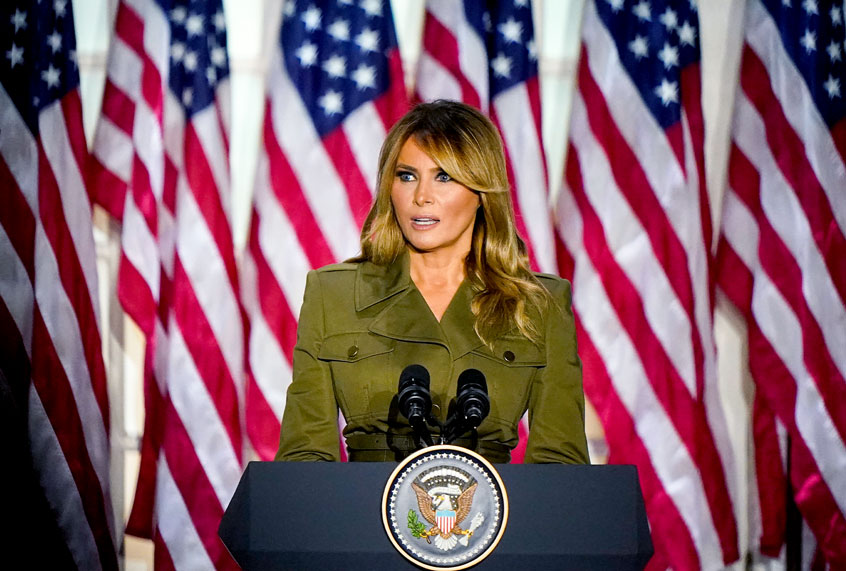Donald Trump blames the sudden appearance of the COVID-19, and the stubborn effects it has created, for blowing the country’s economic success – and for damaging his promised American Greatness.
As a result, we’ve seen an endless parade of announcements to forego safety concerns to go back to work, of would-be treatments and vaccine possibilities, of re-opening efforts that run aground anew as disease spreads.
A basic Republican message in the Republican National Convention this week is that but for the pandemic, Trump had this country on a roll—without mentioning that the roll had begun under his predecessor. Return him for another four years, wink away the pandemic and all that’s ahead is more economic greatness.
Sure, we had low unemployment, and lots of industries seemed to be doing well, though it was unbalanced and hard for lots of people at the lower end of the economy. The sentiment hardly addresses millions out of work.
In any case, it seems horribly unrealistic to just assert that everything is about to bounce back and keep growing. What will emerge is something new that will take a lot of new plans and promises, not the same old ones—regardless of who wins the election.
Now, even that statement belies a lot of anguish in the system: At its best, the successful Trump economy has been tilted heavily toward those already pretty well off – the wealthy, corporations, financial markets and developers.
So, the natural Trump policy has been to cut taxes, regulations and boost private investment and profits that eventually result in more jobs all through the system. Limit health care to those with jobs, cut food stamps and social services and incent those left behind to take underpaid jobs or part-time work to qualify for health care.
Axios.com published a list of Trump economic promises from four years ago that is a useful gauge of progress – or not. The simple truth here is that we might judge Trump’s delivery on those promises even without the effects of the pandemic.
What Trump promised
It’s a fair question if Trump is seeking another four years since his vague promise is to make more of those achievements in the future. He wants to drop payroll taxes and capital gains taxes, for example, make his tax cuts permanent and repeats never-fulfilled promises for a middle-class tax cut, child-care tax credits, and more economic war on China.
Here is some of what Axios reported:
- Trump vowed to “double our growth and have the strongest economy anywhere in the world.” He promises to grow the economy by 4% per year, though in reality, the U.S. economy grew by an average of 2.5% during Trump’s first three years, topping out at 3% in 2018 and falling to 2.2% for 2019.
- Trump said he would reduce the national debt, and eliminate it entirely within eight years. Even before the pandemic, it increased.
- Trade was an important set of promises. Trump did renegotiate NAFTA, a bilateral trade agreement with South Korea, and pulled out of the Trans-Pacific Partnership. There is disagreement about whether the changes were as extensive as described. Trump promised to decrease the trade deficit, but the national trade deficit has been larger in each of Trump’s first three years in office than it was for 2016, per the U.S. Census Bureau. Trade deficits with both Canada and Mexico grew substantially, while the trade deficit with China decreased slightly.
- Tariffs on Chinese imports and the end of theft of American trade secrets have proved more difficult than promised. After two years of tit-for-tat tariffs and stalled trade negotiations, the Trump administration signed a “Phase 1” trade deal earlier this year short of the administration goals.
- Trump said he would “bring back” U.S. manufacturing jobs. U.S. manufacturing jobs rose from 12.36 million in 2016 to 12.87 million in 2019. It’s unclear how many of those jobs came back from overseas, though overall, as of July, there were fewer Americans employed in the manufacturing industry than in 2015. The Institute for Supply Management’s manufacturing index rose and is now contracting.
- Despite promises to put miners and steelworkers back to work, the U.S. coal mining industry gained just 200 net jobs between 2016 and 2019. The number of U.S. steel and ironworker jobs increased by 10.3% in that time. A promise that Apple would start manufacturing here has not come about.
And, so?
Nor has the country been drawing promised foreign investment, nor improved climate control measures, nor appreciably increased the ranks of the middle-class. Poverty numbers are up, hunger is up, health coverage is down. The stock market, which Trump often uses as a measure of success, has proved much more volatile.
I’m one who believes that the president of the United States may be a powerful office, but it may not have full control over whether the economy improves overall. There are too many other factors, from weather to markets to, as we now see, pandemics.
But since these economic matters are the fundamental reason to support Trump in particular, and his Republican supporters, it seems useful to know that the promises are a lot more hit-and-miss than Trump will own.
Pandemic surely has at least temporarily reversed some of Trump’s promised economic advancements.
But overall, there is plenty of objective evidence that the promises – even if they were aimed at creating a certain kind of success that leaves many behind – have not been as good as advertised.
As usual, be careful about what you say you support.



